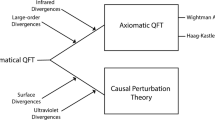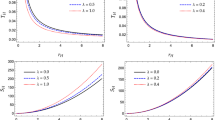Abstract
We present a general strong-coupling approach for the description of an atomic Bose gas beyond the Bogoliubov approximation, when infrared divergences start to occur that need to be resummed exactly. We consider the determination of several important physical properties of the Bose gas, namely the chemical potential, the contact, the speed of sound, the condensate density, the effective interatomic interaction and the three-body recombination rate. It is shown how the approach can be systematically improved with renormalization-group methods and how it reduces to the Bogoliubov theory in the weak-coupling limit.







Similar content being viewed by others
References
C. Chin, R. Grimm, P. Julienne, E. Tiesinga, Rev. Mod. Phys. 82, 1225 (2010)
I. Bloch, J. Dalibard, W. Zwerger, Rev. Mod. Phys. 80, 885 (2008)
H.T.C. Stoof, D.B.M. Dickerscheid, K. Gubbels, Ultracold Quantum Fields, 1st edn. (Springer, Berlin, 2009)
W. Zwerger (ed.), The BCS-BEC Crossover and the Unitary Fermi Gas (Springer, Berlin, 2011) and references therein
M.J.H. Ku, A.T. Sommer, L.W. Cheuk, M.W. Zwierlein, Science 335, 563 (2012)
G. Zürn, T. Lompe, A.N. Wenz, S. Jochim, P.S. Julienne, J.M. Hutson, Phys. Rev. Lett. 110, 135301 (2013)
S.B. Papp, J.M. Pino, R.J. Wild, S. Ronen, C.E. Wieman, D.S. Jin, E.A. Cornell, Phys. Rev. Lett. 101, 135301 (2008)
S.E. Pollack, D. Dries, M. Junker, Y.P. Chen, T.A. Corcovilos, R.G. Hulet, Phys. Rev. Lett. 102, 090402 (2009)
N. Navon, S. Piatecki, K. Günter, B. Rem, T.C. Nguyen, F. Chevy, W. Krauth, C. Salomon, Phys. Rev. Lett. 107, 135301 (2011)
R.J. Wild, P. Makotyn, J.M. Pino, E.A. Cornell, D.S. Jin, Phys. Rev. Lett. 108, 145305 (2012)
B.S. Rem, A.T. Grier, I. Ferrier-Barbut, U. Eismann, T. Langen, N. Navon, L. Khaykovich, F. Werner, D.S. Petrov, F. Chevy, C. Salomon, Phys. Rev. Lett. 110, 163202 (2013)
R.J. Fletcher, A.L. Gaunt, N. Navon, R.P. Smith, Z. Hadzibabic, arXiv:1307.3193
P. Makotyn, C.E. Klauss, D.L. Goldberger, E.A. Cornell, D.S. Jin, arXiv:1308.3696
S. Cowell, H. Heiselberg, I.E. Mazets, J. Morales, V.R. Pandharipande, C.J. Pethick, Phys. Rev. Lett. 88, 210403 (2002)
L. Yin, Phys. Rev. A 77, 043630 (2008)
J.L. Song, F. Zhou, Phys. Rev. Lett. 103, 025302 (2009)
Y.L. Lee, Y.W. Lee, Phys. Rev. A 81, 063613 (2010)
J.M. Diederix, T.C.F. van Heijst, H.T.C. Stoof, Phys. Rev. A 84, 033618 (2011)
W. Li, T.L. Ho, Phys. Rev. Lett. 108, 195301 (2012)
D. Borzov, M.S. Mashayekhi, S. Zhang, J.L. Song, F. Zhou, Phys. Rev. A 85, 023620 (2012)
S.K. Adhikari, L. Salasnich, Phys. Rev. A 77, 033618 (2008)
F. Cooper, C.C. Chien, B. Mihaila, J.F. Dawson, E. Timmermans, Phys. Rev. Lett. 105, 240402 (2010)
F. Zhou, M.S. Mashayekhi, Ann. Phys. 328, 83 (2013)
S.-J. Jiang, W.-M. Liu, G.W. Semenoff, F. Zhou, arXiv:1307.4263
J. Gavoret, P. Nozières, Ann. Phys. 28, 349 (1964)
V.N. Popov, Theor. Math. Phys. 6, 65 (1971)
V.N. Popov, Theor. Math. Phys. 11, 478 (1972)
A.A. Nepomnyashchii, Y. Nepomnyashchii, JETP Lett. 21, 3 (1975)
Y. Nepomnyashchii, A.A. Nepomnyashchii, JETP Lett. 48, 493 (1978)
T.D. Lee, K. Huang, C.N. Yang, Phys. Rev. 106, 1135 (1957)
E. Braaten, H.W. Hammer, T. Mehen, Phys. Rev. Lett. 88, 040401 (2002)
S. Tan, Ann. Phys. 323, 2952 (2008)
S. Tan, Ann. Phys. 323, 2971 (2008)
E. Braaten, L. Platter, Phys. Rev. Lett. 100, 205301 (2008)
R. Combescot, F. Alzetto, X. Leyronas, Phys. Rev. A 79, 053640 (2009)
A.M.J. Schakel, arXiv:1007.3452
F. Werner, Y. Castin, Phys. Rev. A 86, 053633 (2012)
N. Dupuis, Phys. Rev. E 83, 031120 (2011)
N.M. Hugenholtz, D. Pines, Phys. Rev. 116, 489 (1959)
K.B. Gubbels, H.T.C. Stoof, Phys. Rev. Lett. 100, 140407 (2008)
E. Braaten, D. Kang, L. Platter, Phys. Rev. Lett. 106, 153005 (2011)
E. Braaten, H.W. Hammer, Phys. Rep. 428, 259 (2006)
M. Zaccanti, B. Deissler, C.D. Errico, M. Fattori, M. Jona-Lasinio, S. Muller, G. Roati, M. Inguscio, G. Modugno, Nat. Phys. 5 (2009). doi:10.1038/nphys1334
S.E. Pollack, D. Dries, R.G. Hulet, Science 326, 1683 (2009)
S. Moroz, S. Floerchinger, R. Schmidt, C. Wetterich, Phys. Rev. A 79, 042705 (2009)
S. Floerchinger, S. Moroz, R. Schmidt, Few-Body Syst. 51, 153 (2011)
Acknowledgements
This work is supported by the Stichting voor Fundamenteel Onderzoek der Materie (FOM) and the Nederlandse Organisatie voor Wetenschaplijk Onderzoek (NWO).
Author information
Authors and Affiliations
Corresponding author
Appendices
Appendix A: Ladder and Bubble-Sum Contributions
In this section the ladder and bubble-sum contributions to the effective interaction are derived. The full energy-momentum and temperature-dependent ladder contribution is
where we defined \(\mathbf{k}'_{\pm}=\mathbf{k}/2\pm\mathbf{k}'\), \(n'_{\pm}=n/2\pm n'\), (ħω k )2=ϵ k (ϵ k +2mc 2) and the coherence factors \(u_{\mathbf{k}}^{2}=v_{\mathbf{k}}^{2}+1= (\hbar\omega_{\mathbf{k}}+\epsilon_{\mathbf{k}} )/2\hbar\omega_{\mathbf{k}}\). The bubble diagram is given by
whose form is obtained from Eq. (A.1) by substituting \(u_{\mathbf{k}'_{-}}^{2}\leftrightarrow-v_{\mathbf{k}'_{-}}^{2}\), while not modifying \(u_{\mathbf{k}'_{+}}^{2},v_{\mathbf{k}'_{+}}^{2}\), in the expression for the ladder contribution. In the zero-temperature limit only the first and last line of both the ladder and bubble sum contribution survives, where the former is
In cold atomic gases the momentum dependence of these quantities is of little importance. The momentum-independent ladder and bubble sum contributions can then be integrated analytically, however, due to the size of the expressions they are not shown here. Evaluating the expressions also at zero frequency we obtain
For the non-interacting case, where ħω k =ϵ k and \(u_{\mathbf{k}}^{2}=v_{\mathbf{k}}^{2}+1=1\), we have that the bubble sum contribution vanishes and that at zero momentum the ladder contribution becomes
where z=iħω n and an ultra-violet subtraction was needed as a consequence of the point interaction and in agreement with Eq. (20).
Appendix B: Renormalization Group
Here we derive the renormalization-group flow equation. Starting from the action of a homogeneous Bose gas as shown in Eq. (2), we take the Fourier transform of the fields
and split up the field in terms of low-momentum ϕ < and high-momentum modes ϕ > as
where the low-momentum and high-momentum modes are defined as
Rewriting the partition function leads to
where the gaussian part of the action is denoted by S 0[ϕ ∗,ϕ] and the non-gaussian part by S int[ϕ ∗,ϕ]. Expanding up to second order in the high-momentum fields gives
Here the trace is over momentum, frequency and Nambu space Φ(k,ω n )=[ϕ(k,ω n ),ϕ ∗(−k,−ω n )]T. By integrating out the high-momentum fields, we obtain the effective action for the low-momentum fields
Thus the change in the action after integrating out the high-momentum modes is given by, using that the trace is over an infinitesimal momentum interval Λ<k<Λ+dΛ,
Appendix C: Ultra-Violet Subtractions
To calculate the condensate density and total density an ultra-violet subtraction is necessary, see Eq. (17) and Eq. (19). This subtraction is a consequence of the renormalization of the bare coupling to the two-body T matrix T 2B(−2mc 2) [3]. The phase-fluctuation and non-phase-fluctuation propagator in real space are written as
where mc 2=n 0 g and the propagators are defined in Eqs. (14) and (15). This implies that the equal-time correlation function 〈θ(x,0)θ(0,0)〉 with ultra-violet subtraction at zero temperature is given by
In the long-range limit (|x|→∞) we have that this expression vanishes, which is used to define the condensate density in Eq. (17). Whereas the equal-time correlation function of the non-phase fluctuations 〈ϕ′(x,0)ϕ ′∗(0,0)〉 with the ultra-violet subtraction at zero-temperature is
The contribution to the total density due to non-phase-fluctuations follows from evaluating this expression at equal position n′=〈ϕ′(0,0)ϕ ′∗(0,0)〉.
Rights and permissions
About this article
Cite this article
Stoof, H.T.C., van Heugten, J.J.R.M. Resummation of Infrared Divergencies in the Theory of Atomic Bose Gases. J Low Temp Phys 174, 159–183 (2014). https://doi.org/10.1007/s10909-013-0958-7
Received:
Accepted:
Published:
Issue Date:
DOI: https://doi.org/10.1007/s10909-013-0958-7




